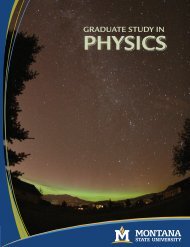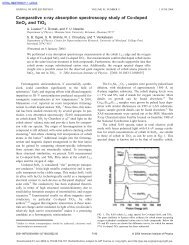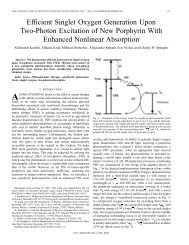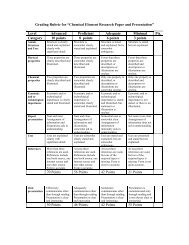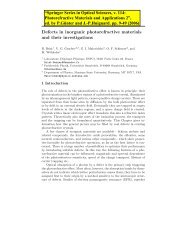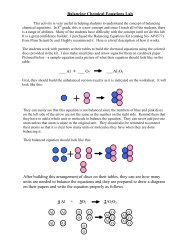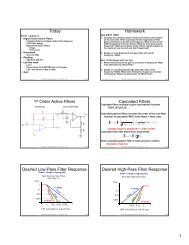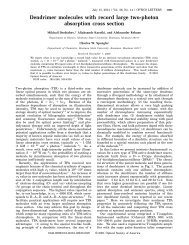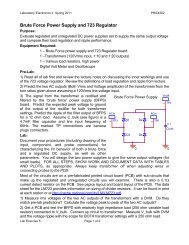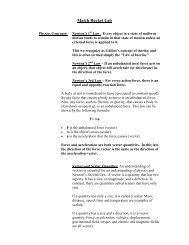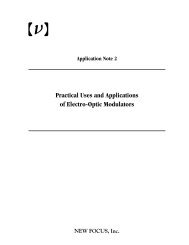Journal of Luminescence 107 (2004) - Department of Physics ...
Journal of Luminescence 107 (2004) - Department of Physics ...
Journal of Luminescence 107 (2004) - Department of Physics ...
You also want an ePaper? Increase the reach of your titles
YUMPU automatically turns print PDFs into web optimized ePapers that Google loves.
ARTICLE IN PRESS<br />
M. Drobizhev et al. / <strong>Journal</strong> <strong>of</strong> <strong>Luminescence</strong> <strong>107</strong> (<strong>2004</strong>) 194–202 199<br />
fluorescence spectrum:<br />
Fðn; TÞ<br />
¼ KðnÞ½1 þ MðTÞ cosð2pDtn þ DjðTÞÞŠ;<br />
ð7Þ<br />
where the amplitude MðTÞ and the phase shift<br />
DjðTÞ <strong>of</strong> the grating are given by<br />
MðTÞ ¼bf½A þ B cos d 2 þ C cos d 1<br />
þ D cosðd 1 þ d 2 ÞŠ 2<br />
þ½B sin d 2 þ C sin d 1<br />
þ D sinðd 1 þ d 2 ÞŠ 2 g 1=2 ;<br />
ð8Þ<br />
DjðTÞ<br />
B sin d 2 þ C sin d 1 þ D sinðd 1 þ d 2 Þ<br />
¼ arctg<br />
A þ B cos d 2 þ C cos d 1 þ D cosðd 1 þ d 2 Þ :<br />
ð9Þ<br />
Here functions AðTÞ; BðTÞ; CðTÞ; and DðTÞ are<br />
expressed through the model parameters as<br />
follows:<br />
AðTÞ ¼a 1 ðTÞa 2 ðTÞ;<br />
ð10Þ<br />
BðTÞ ¼½1 a 1 ðTÞŠa 2 ðTÞ<br />
f1 þðpDtn 2 Þ 2 g 3=2 ;<br />
CðTÞ ¼a 1 ðTÞ½1 a 2 ðTÞŠ<br />
f1 þðpDtn 1 Þ 2 g 3=2 ;<br />
DðTÞ ¼½1 a 1 ðTÞŠ½1 a 2 ðTÞŠ<br />
f½1 þðpDtn 2 Þ 2 Š½1 þðpDtn 1 Þ 2 Šg 3=2<br />
ð11Þ<br />
ð12Þ<br />
ð13Þ<br />
and<br />
d 1; 2 ¼ 3 arctgðpDtn 1; 2 Þ:<br />
ð14Þ<br />
We note here that in the limiting case a 1 ð0Þ ¼<br />
a 2 ð0Þ ¼1 Eq. (9) does give a quantitativelycorrect<br />
phase shift, Djð0Þ ¼0: However, for example, for<br />
a 1 ¼ a 2 ¼ 0; the correct behavior is reproduced<br />
onlyat small pDtn 1; 2 : Dj ¼ 3pDtðn 1 þ n 2 Þ: This<br />
last value corresponds to a frequencyshift (Stokes<br />
shift) <strong>of</strong> Dn ¼ 3 2 ðn 1 þ n 2 Þ; equal to a difference<br />
between centers <strong>of</strong> gravity<strong>of</strong> PWs (5) in absorption<br />
and fluorescence. In general case, the values <strong>of</strong><br />
Dj allowed byEq. (9) are restricted bydefinition<br />
<strong>of</strong> function arctgðxÞ; and, therefore, Eq. (9) is<br />
unable to describe a wide range <strong>of</strong> other real sets <strong>of</strong><br />
parameters. In our approach we use Eq. (8) for the<br />
simulation <strong>of</strong> the temperature dependence <strong>of</strong> the<br />
amplitude (contrast) <strong>of</strong> the fringes, but we resort<br />
to a simpler model for the simulation <strong>of</strong> the<br />
temperature dependence <strong>of</strong> the phase. We consider<br />
the Stokes shift as a difference between the first<br />
moments (centers <strong>of</strong> gravity) <strong>of</strong> absorption and<br />
fluorescence homogeneous spectra, namely,<br />
DnðTÞ ¼ð1 a 2 ðTÞÞn 2<br />
þð1 a 1 ðTÞÞn 1 ; ð15Þ<br />
and, therefore,<br />
DjðTÞ ¼2pDt½ð1 a 2 ðTÞÞn 2<br />
þð1 a 1 ðTÞÞn 1 Š: ð16Þ<br />
5. Results <strong>of</strong> simulations and discussion<br />
5.1. Chl in PVB<br />
First <strong>of</strong> all, we simulated the temperature<br />
dependence <strong>of</strong> the fringes in Chl:PVB system by<br />
using symmetrical model with x 1 ¼ x 2 ¼ x and<br />
Phase shift, ∆ϕ (rad) Modulation amplitude, M<br />
(a)<br />
(b)<br />
0.3<br />
0.2<br />
0.1<br />
3<br />
2<br />
1<br />
20 40 60 80 100 120<br />
T, K<br />
40 60 80 100<br />
Fig. 5. Temperature dependence <strong>of</strong> the amplitude M (a) and<br />
phase shift Dj (b) <strong>of</strong> spectral grating observed in Chl:PVB and<br />
corresponding fits <strong>of</strong> these data to Eqs. (8) and (16) in mirrorsymmetrical<br />
model.



